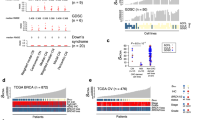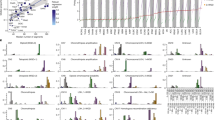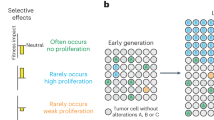Abstract
Alteration in DNA copy number is one of the many ways in which gene expression and function may be modified. Some variations are found among normal individuals, others occur in the course of normal processes in some species and still others participate in causing various disease states. For example, many defects in human development are due to gains and losses of chromosomes and chromosomal segments that occur before or shortly after fertilization, and DNA dosage-alteration changes occurring in somatic cells are frequent contributors to cancer. Detecting these aberrations and interpreting them in the context of broader knowledge facilitates the identification of crucial genes and pathways involved in biological processes and disease. Over the past several years, array comparative genomic hybridization has proven its value for analyzing DNA copy-number variations. Here, we discuss the state of the art of array comparative genomic hybridization and its applications in cancer, emphasizing general concepts rather than specific results.
This is a preview of subscription content, access via your institution
Access options
Subscribe to this journal
Receive 12 print issues and online access
$259.00 per year
only $21.58 per issue
Buy this article
- Purchase on SpringerLink
- Instant access to full article PDF
Prices may be subject to local taxes which are calculated during checkout




Similar content being viewed by others
References
Kallioniemi, A. et al. Comparative genomic hybridization for molecular cytogenetic analysis of solid tumors. Science 258, 818–821 (1992).
du Manoir, S. et al. Detection of complete and partial chromosome gains and losses by comparative genomic in situ hybridization. Hum. Genet. 90, 590–610 (1993).
Karhu, R., Rummukainen, J., Lorch, T. & Isola, J. Four-color CGH: a new method for quality control of comparative genomic hybridization. Genes Chromosomes Cancer 24, 112–118 (1999).
Mohapatra, G. et al. Analyses of brain tumor cell lines confirm a simple model of relationships among fluorescence in situ hybridization, DNA index, and comparative genomic hybridization. Genes Chromosomes Cancer 20, 311–319 (1997).
Solinas-Toldo, S. et al. Matrix-based comparative genomic hybridization: biochips to screen for genomic imbalances. Genes Chromosomes Cancer 20, 399–407 (1997).
Pinkel, D. et al. High resolution analysis of DNA copy number variation using comparative genomic hybridization to microarrays. Nat. Genet. 20, 207–211 (1998).
Snijders, A.M. et al. Assembly of microarrays for genome-wide measurement of DNA copy number. Nat. Genet. 29, 263–264 (2001).
Hodgson, G. et al. Genome scanning with array CGH delineates regional alterations in mouse islet carcinomas. Nat. Genet. 29, 459–464 (2001).
Fiegler, H. et al. DNA microarrays for comparative genomic hybridization based on DOP-PCR amplification of BAC and PAC clones. Genes Chromosomes Cancer 36, 361–374 (2003).
Smirnov, D.A., Burdick, J.T., Morley, M. & Cheung, V.G. Method for manufacturing whole-genome microarrays by rolling circle amplification. Genes Chromosomes Cancer 40, 72–77 (2004).
Ishkanian, A.S. et al. A tiling resolution DNA microarray with complete coverage of the human genome. Nat. Genet. 36, 299–303 (2004).
Li, J. et al. Genomic segmental polymorphisms in inbred mouse strains. Nat. Genet. 36, 952–954 (2004).
Pollack, J.R. et al. Genome-wide analysis of DNA copy-number changes using cDNA microarrays. Nat. Genet. 23, 41–46 (1999).
Mantripragada, K.K. et al. DNA copy-number analysis of the 22q11 deletion-syndrome region using array-CGH with genomic and PCR-based targets. Int. J. Mol. Med. 13, 273–279 (2004).
Dhami, P. et al. Exon array-CGH: detection of copy number changes at the resolution of individual exons in the human genome. Am. J. Hum. Genet. 76, 750–762 (2005).
Brennan, C. et al. High-resolution global profiling of genomic alterations with long oligonucleotide microarray. Cancer Res. 64, 4744–4748 (2004).
Carvalho, B., Ouwerkerk, E., Meijer, G.A. & Ylstra, B. High resolution microarray comparative genomic hybridisation analysis using spotted oligonucleotides. J. Clin. Pathol. 57, 644–646 (2004).
Lucito, R. et al. Detecting gene copy number fluctuations in tumor cells by microarray analysis of genomic representations. Genome Res. 10, 1726–1736 (2000).
Zhao, X. et al. An integrated view of copy number and allelic alterations in the cancer genome using single nucleotide polymorphism arrays. Cancer Res. 64, 3060–3071 (2004).
Zhou, X., Mok, S.C., Chen, Z., Li, Y. & Wong, D.T. Concurrent analysis of loss of heterozygosity (LOH) and copy number abnormality (CNA) for oral premalignancy progression using the Affymetrix 10K SNP mapping array. Hum. Genet. 115, 327–330 (2004).
Pinkel, D. & Albertson, D. Array comparative genomic hybridization. Ann. Rev. Genet. Genomics (in the press).
Fukiya, S., Mizoguchi, H., Tobe, T. & Mori, H. Extensive genomic diversity in pathogenic Escherichia coli and Shigella strains revealed by comparative genomic hybridization microarray. J. Bacteriol. 186, 3911–3921 (2004).
Watanabe, T., Murata, Y., Oka, S. & Iwahashi, H. A new approach to species determination for yeast strains: DNA microarray-based comparative genomic hybridization using a yeast DNA microarray with 6000 genes. Yeast 21, 351–365 (2004).
Albertson, D.G. et al. Quantitative mapping of amplicon structure by array CGH identifies CYP24 as a candidate oncogene. Nat. Genet. 25, 144–146 (2000).
Sebat, J. et al. Large-scale copy number polymorphism in the human genome. Science 305, 525–528 (2004).
Barrett, M.T. et al. Comparative genomic hybridization using oligonucleotide microarrays and total genomic DNA. Proc. Natl. Acad. Sci. USA 101, 17765–17770 (2004).
Wang, N.J., Liu, D., Parokonny, A.S. & Schanen, N.C. High-resolution molecular characterization of 15q11-q13 rearrangements by array comparative genomic hybridization (array CGH) with detection of gene dosage. Am. J. Hum. Genet. 75, 267–281 (2004).
Lupski, J.R., Roth, J.R. & Weinstock, G.M. Chromosomal duplications in bacteria, fruit flies, and humans. Am. J. Hum. Genet. 58, 21–27 (1996).
Eichler, E.E. Segmental duplications: what's missing, misassigned, and misassembled– and should we care? Genome Res. 11, 653–656 (2001).
Emanuel, B.S. & Shaikh, T.H. Segmental duplications: an 'expanding' role in genomic instability and disease. Nat. Rev. Genet. 2, 791–800 (2001).
Zhang, X. et al. High-resolution mapping of genotype-phenotype relationships in cri du chat syndrome using array comparative genomic hybridization. Am. J. Hum. Genet. 76, 312–326 (2005).
Locke, D.P. et al. BAC microarray analysis of 15q11-q13 rearrangements and the impact of segmental duplications. J. Med. Genet. 41, 175–182 (2004).
Albertson, D.G. & Pinkel, D. Genomic microarrays in human genetic disease and cancer. Hum. Mol. Genet. 12 special issue 2, R145–R152 (2003).
Iafrate, A.J. et al. Detection of large-scale variation in the human genome. Nat. Genet. 36, 949–951 (2004).
Snijders, A.M. et al. Mapping segmental and sequence variations among laboratory mice using BAC array CGH. Genome Res. 15, 302–311 (2005).
Utermann, G. et al. Lp(a) glycoprotein phenotypes. Inheritance and relation to Lp(a)-lipoprotein concentrations in plasma. J. Clin. Invest. 80, 458–465 (1987).
DeVries, S. et al. Array-based comparative genomic hybridization from formalin-fixed, paraffin-embedded breast tumors. J. Mol. Diagn. 7, 1–7 (2005).
Snijders, A.M. et al. Rare amplicons implicate misspecification of cell fate in oral squamous cell carcinoma. Oncogene published online, 11 April 2005 (10.1038/sj.onc.1208601).
Lage, J.M. et al. Whole genome analysis of genetic alterations in small DNA samples using hyperbranched strand displacement amplification and array-CGH. Genome Res. 13, 294–307 (2003).
Hosono, S. et al. Unbiased whole-genome amplification directly from clinical samples. Genome Res. 13, 954–964 (2003).
Daigo, Y. et al. Degenerate oligonucleotide primed-polymerase chain reaction-based array comparative genomic hybridization for extensive amplicon profiling of breast cancers: a new approach for the molecular analysis of paraffin-embedded cancer tissue. Am. J. Pathol. 158, 1623–1631 (2001).
Wang, G. et al. Balanced-PCR amplification allows unbiased identification of genomic copy changes in minute cell and tissue samples. Nucleic Acids Res. 32, e76 (2004).
Guillaud-Bataille, M. et al. Detecting single DNA copy number variations in complex genomes using one nanogram of starting DNA and BAC-array CGH. Nucleic Acids Res. 32, e112 (2004).
Tanabe, C. et al. Evaluation of a whole-genome amplification method based on adaptor-ligation PCR of randomly sheared genomic DNA. Genes Chromosomes Cancer 38, 168–176 (2003).
Liu, D. et al. LM-PCR permits highly representative whole genome amplification of DNA isolated from small number of cells and paraffin-embedded tumor tissue sections. Diagn. Mol. Pathol. 13, 105–115 (2004).
Wang, G. et al. DNA amplification method tolerant to sample degradation. Genome Res. 14, 2357–2366 (2004).
Fridlyand, J., Snijders, A.M., Pinkel, D., Albertson, D.G. & Jain, A.N. Hidden Markov models approach to the analysis of array CGH data. J. Multivariate Anal. 90, 132–153 (2004).
Olshen, A.B., Venkatraman, E.S., Lucito, R. & Wigler, M. Circular binary segmentation for the analysis of array-based DNA copy number data. Biostatistics 5, 557–572 (2004).
Hupe, P., Stransky, N., Thiery, J.P., Radvanyi, F. & Barillot, E. Analysis of array CGH data: from signal ratio to gain and loss of DNA regions. Bioinformatics 20, 3413–3422 (2004).
Daruwala, R.S. et al. A versatile statistical analysis algorithm to detect genome copy number variation. Proc. Natl. Acad. Sci. USA 101, 16292–16297 (2004).
Wang, P., Kim, Y., Pollack, J., Narasimhan, B. & Tibshirani, R. A method for calling gains and losses in array CGH data. Biostatistics 6, 45–58 (2005).
Bocker, T., Ruschoff, J. & Fishel, R. Molecular diagnostics of cancer predisposition: hereditary non-polyposis colorectal carcinoma and mismatch repair defects. Biochim. Biophys. Acta 1423, O1–O10 (1999).
Esteller, M. Epigenetic lesions causing genetic lesions in human cancer: promoter hypermethylation of DNA repair genes. Eur. J. Cancer 36, 2294–2300 (2000).
Snijders, A.M. et al. Shaping of tumor and drug-resistant genomes by instability and selection. Oncogene 22, 4370–4379 (2003).
O'Hagan, R.C. et al. Telomere dysfunction provokes regional amplification and deletion in cancer genomes. Cancer Cell 2, 149–155 (2002).
Waldman, F.M. et al. Chromosomal alterations in ductal carcinomas in situ and their in situ recurrences. J. Natl. Cancer Inst. 92, 313–320 (2000).
Albertson, D.G. Profiling breast cancer by array CGH. Breast Cancer Res. Treat. 78, 289–298 (2003).
Chin, K. et al. In situ analyses of genome instability in breast cancer. Nat. Genet. 36, 984–988 (2004).
Schwaenen, C. et al. Automated array-based genomic profiling in chronic lymphocytic leukemia: development of a clinical tool and discovery of recurrent genomic alterations. Proc. Natl. Acad. Sci. USA 101, 1039–1044 (2004).
Paris, P.L. et al. Whole genome scanning identifies genotypes associated with recurrence and metastasis in prostate tumors. Hum. Mol. Genet. 13, 1303–1313 (2004).
Callagy, G. et al. Identification and validation of prognostic markers in breast cancer with the complementary use of array-CGH and tissue microarrays. J. Pathol. 205, 388–396 (2005).
Weiss, M.M. et al. Genomic alterations in primary gastric adenocarcinomas correlate with clinicopathological characteristics and survival. Cell. Oncol. 26, 307–317 (2004).
Martinez-Climent, J.A. et al. Transformation of follicular lymphoma to diffuse large cell lymphoma is associated with a heterogeneous set of DNA copy number and gene expression alterations. Blood 101, 3109–3117 (2003).
Rubio-Moscardo, F. et al. Mantel cell lymphoma genotypes identified with CGH to BAC microarrays define a leukemic subgroup of disease and predict patient outcome. Blood published online 17 February 2005 (10.1182/blood-2004-10-3907).
Ioannidis, J.P., Ntzani, E.E., Trikalinos, T.A. & Contopoulos-Ioannidis, D.G. Replication validity of genetic association studies. Nat. Genet. 29, 306–309 (2001).
Freedman, M.L. et al. Assessing the impact of population stratification on genetic association studies. Nat. Genet. 36, 388–393 (2004).
Pollack, J.R. et al. Microarray analysis reveals a major direct role of DNA copy number alteration in the transcriptional program of human breast tumors. Proc. Natl. Acad. Sci. USA 99, 12963–12968 (2002).
Heidenblad, M. et al. Microarray analyses reveal strong influence of DNA copy number alterations on the transcriptional patterns in pancreatic cancer: implications for the interpretation of genomic amplifications. Oncogene 24, 1794–1801 (2005).
Hyman, E. et al. Impact of DNA amplification on gene expression patterns in breast cancer. Cancer Res. 62, 6240–6245 (2002).
Press, M.F. et al. Evaluation of HER-2/neu gene amplification and overexpression: comparison of frequently used assay methods in a molecularly characterized cohort of breast cancer specimens. J. Clin. Oncol. 20, 3095–3105 (2002).
Maldonado, J.L. et al. Determinants of BRAF mutations in primary melanomas. J. Natl. Cancer Inst. 95, 1878–1890 (2003).
Ewart-Toland, A. et al. Identification of Stk6/STK15 as a candidate low-penetrance tumor-susceptibility gene in mouse and human. Nat. Genet. 34, 403–412 (2003).
Zardo, G. et al. Integrated genomic and epigenomic analyses pinpoint biallelic gene inactivation in tumors. Nat. Genet. 32, 453–458 (2002).
Cox, C. et al. A survey of homozygous deletions in human cancer genomes. Proc. Natl. Acad. Sci. USA 102, 4542–4547 (2005).
Huusko, P. et al. Nonsense-mediated decay microarray analysis identifies mutations of EPHB2 in human prostate cancer. Nat. Genet. 36, 979–983 (2004).
Author information
Authors and Affiliations
Ethics declarations
Competing interests
The authors declare no competing financial interests.
Rights and permissions
About this article
Cite this article
Pinkel, D., Albertson, D. Array comparative genomic hybridization and its applications in cancer. Nat Genet 37 (Suppl 6), S11–S17 (2005). https://doi.org/10.1038/ng1569
Issue date:
DOI: https://doi.org/10.1038/ng1569
This article is cited by
-
SCYN: single cell CNV profiling method using dynamic programming
BMC Genomics (2021)
-
A scalable multiple pairwise protein sequence alignment acceleration using hybrid CPU–GPU approach
Cluster Computing (2020)
-
Copy Number Aberrations of Multiple Genes Identified as Prognostic Markers for Extrahepatic Metastasis-free Survival of Patients with Hepatocellular Carcinoma
Current Medical Science (2019)
-
ACGH detects distinct genomic alterations of primary intrahepatic cholangiocarcinomas and matched lymph node metastases and identifies a poor prognosis subclass
Scientific Reports (2018)



